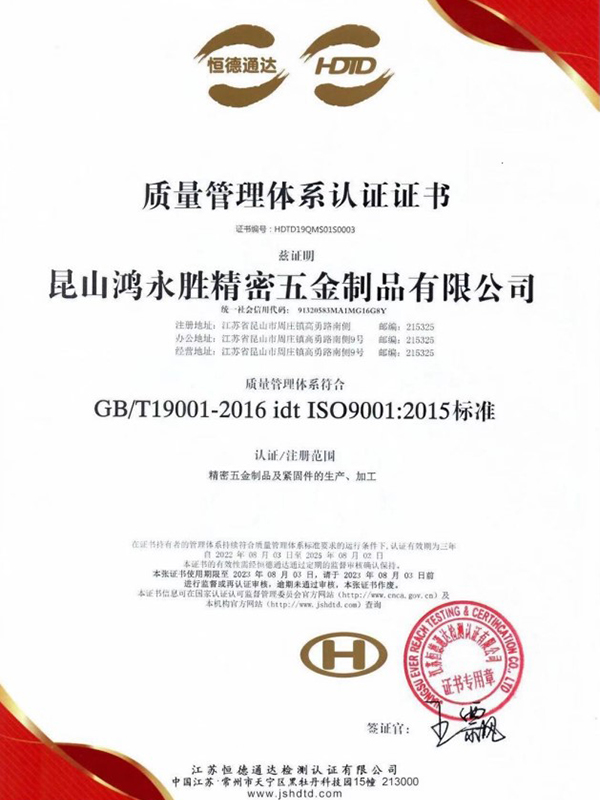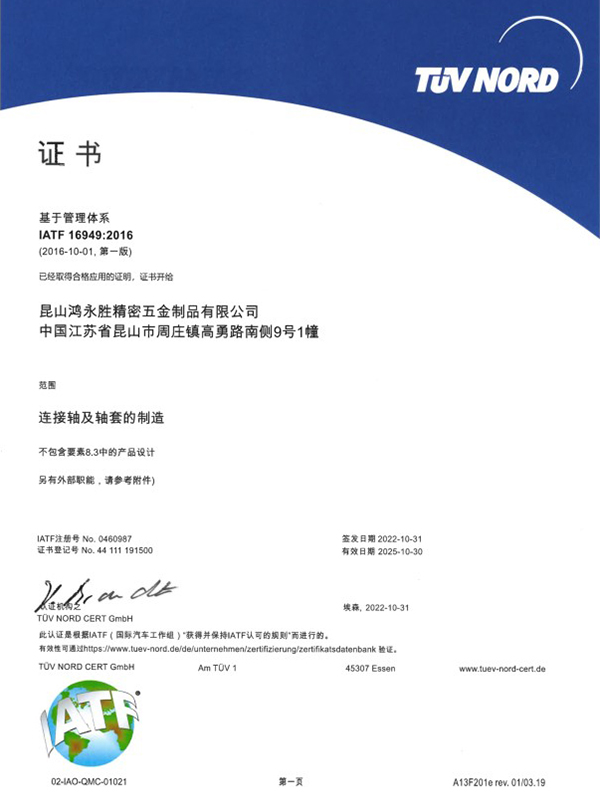Carbon Steel Bolt Supplier Guide: What Buyers Should Look For Selecting the right supplier for carbon steel bolts affects product performance, safety, and long-term cost. This guide breaks down the p...
READ MOREThe company has obtained two quality system management certificates of ISO9001:2015 and IATF16949:2016.
At present, the company has been for Japan, Sweden, the United States, Singapore, Malaysia, Hong Kong and the Pearl River Delta and many other customers to provide services, now the main customers are: Japan Sharp (SHARP), Japan SMC, Japan Panasonic (Panasonic), the Swedish automobile VOVOL, etc., all the fixed assets investment of more than 30 million dollars, welcome friends from all walks of life to the factory to visit, study, consulting and come! We welcome friends from all walks of life to visit our factory, investigate, consult and come to us for sample processing.
We are looking forward to establishing a good business partnership with you with mutual trust and reciprocity!
-
-
Introduction: The Foundation of Mechanical Systems In the intricate world of modern manufacturing and engineering, machined parts form the fundamental building blocks of virtually every mechanical sys...
READ MORE -
Why Structural Integrity Matters In construction, machinery, and other industrial applications, structural integrity is crucial for safety, performance, and longevity. One of the key elements in ensur...
READ MORE -
Introduction to Stainless Steel Fasteners Stainless steel fasteners are widely used in construction, machinery, and industrial applications due to their corrosion resistance and durability. Among them...
READ MORE
What is the wonderful thing about stainless steel welding nails?
In the world of construction, innovation is key to achieving sturdy and long-lasting structures. One such innovation that has revolutionized the industry is the use of stainless steel welding nails. These tiny but mighty fasteners have garnered attention for their exceptional strength and durability.
Stainless steel welding nails are a game-changer in construction due to their remarkable strength and resistance to corrosion. Unlike traditional nails, these modern marvels are specifically designed to withstand harsh environments, making them ideal for outdoor applications. The secret lies in their composition: stainless steel, an alloy consisting of iron, chromium, and other elements that provide superior strength and immunity to rust. This means that structures built with stainless steel welding nails are not only aesthetically pleasing but also built to last for years, even in the face of extreme weather conditions.
The benefits of stainless steel welding nails extend beyond their durability. Their versatility makes them an indispensable tool in various construction projects, from residential homes to massive infrastructure developments. For instance, in timber construction, stainless steel welding nails offer exceptional holding power, ensuring that beams and joints remain securely fastened. Additionally, these nails are widely used in the installation of siding, roofing, and decking materials, where their resistance to corrosion proves invaluable, especially in coastal areas or regions with high humidity.
One cannot underestimate the impact of stainless steel welding nails on the overall cost-effectiveness of construction projects. Although initially pricier than their traditional counterparts, their longevity and resistance to corrosion significantly reduce maintenance and replacement costs in the long run. Moreover, the aesthetic appeal of stainless steel welding nails adds value to properties, making them a popular choice among homeowners and investors alike. It's a win-win situation for both builders and clients, as structures built with these nails not only stand the test of time but also retain their visual appeal.
The rise of stainless steel welding nails has forever changed the construction industry. Their exceptional strength, resistance to corrosion, and versatility make them an indispensable tool for builders across the globe. From residential homes to large-scale infrastructure projects, these fasteners ensure the longevity and visual appeal of structures. As the demand for sustainable and durable construction materials continues to grow, stainless steel welding nails remain at the forefront, revolutionizing the way we build. So, the next time you marvel at a sturdy and beautiful structure, remember the unsung hero behind it – the stainless steel welding nail!



 русский
русский Español
Español


